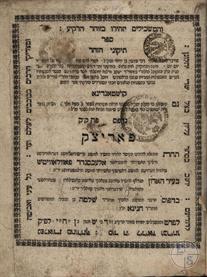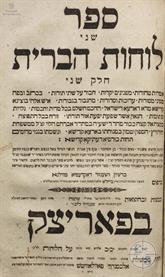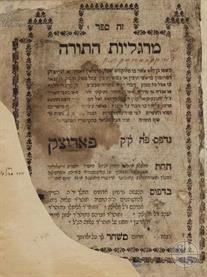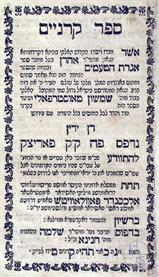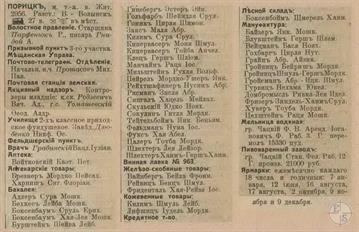Pavlivka (Poryck, Poritsk)
Sources:
- Jewish encyclopedia of Brockhaus & Efron;
- Russian Jewish encyclopedia;
- Yad Vashem. Poryck;
- European Jewish Cemeteries Initiative. Pavlivka Jewish Cemetery;
- The All South-Western Territory: reference and address book of the Kyiv, Podolsk and Volyn provinces. Printing house L.M. Fish and P.E. Wolfson, 1913.
Photo:
- Center for Jewish Art. Poryck (Poritsk, Porysk, now Pavlivka)
- Jan Bulhak (1934), Instytut Sztuki Polskiej Akademii Nauk
- D-r Z. Morwitz. Orłowicz Meczysław. Ilustrowany przewodnik po Wołyniu. Łuck, 1929
- Archive of Andriy Klenk
- Jewish encyclopedia of Brockhaus & Efron;
- Russian Jewish encyclopedia;
- Yad Vashem. Poryck;
- European Jewish Cemeteries Initiative. Pavlivka Jewish Cemetery;
- The All South-Western Territory: reference and address book of the Kyiv, Podolsk and Volyn provinces. Printing house L.M. Fish and P.E. Wolfson, 1913.
Photo:
- Center for Jewish Art. Poryck (Poritsk, Porysk, now Pavlivka)
- Jan Bulhak (1934), Instytut Sztuki Polskiej Akademii Nauk
- D-r Z. Morwitz. Orłowicz Meczysław. Ilustrowany przewodnik po Wołyniu. Łuck, 1929
- Archive of Andriy Klenk
Volodymyr district, Volyn region
Poryck, now called Pavlivka, is located in the Volhynia region of Ukraine, former Poland. After the partition of Poland, the town became a part of the Russian empire.
The first mention of the Jews in Poryck (Pavlivka) dates back to 1569. It can be presumed that Jews were already living in the town earlier, when fire damaged it in 1554.
The Jewish community of Poryck was represented in the Council of the Four Lands.
In the early 18th century, the Jews of Poryck were subordinated to the community of Ludmir (Volodymyr-Volyns’kyy).
By the end of the 18th century, the Jewish population increased from 101 in 1784 to 296 in 1790. During this period, local authorities approved the establishment of a Jewish printing house in 1786, which was actively publishing books by 1790.
The first mention of the Jews in Poryck (Pavlivka) dates back to 1569. It can be presumed that Jews were already living in the town earlier, when fire damaged it in 1554.
The Jewish community of Poryck was represented in the Council of the Four Lands.
In the early 18th century, the Jews of Poryck were subordinated to the community of Ludmir (Volodymyr-Volyns’kyy).
By the end of the 18th century, the Jewish population increased from 101 in 1784 to 296 in 1790. During this period, local authorities approved the establishment of a Jewish printing house in 1786, which was actively publishing books by 1790.
After the partition of Poland, Poryck was located in border region of the Russian Empire to Austrian territory. During the second half of the 19th century, Jews were legislatively forbidden to reside in the border territory. This presumably led to an extreme reduction of Poryck’s Jewish population: 1,100 Jews were counted in 1847, while in 1870, only 327 Jews lived in the town.
According to census data, the Jewish population had again risen to 1,316 Jews (60% of the total population) by 1897. During this period, the town had a synagogue, and one of its rabbis, Kolonius Kalman Horovitz (? – 1885), was the grandson of the “Seer of Lublin” (Rabbi Yaakov Yitzchak HaLevi Horowitz).
In 1913, Jews owned the only warehouse of wood and all 47 shops in township (including 27 grocery, 13 manufactory).
According to census data, the Jewish population had again risen to 1,316 Jews (60% of the total population) by 1897. During this period, the town had a synagogue, and one of its rabbis, Kolonius Kalman Horovitz (? – 1885), was the grandson of the “Seer of Lublin” (Rabbi Yaakov Yitzchak HaLevi Horowitz).
In 1913, Jews owned the only warehouse of wood and all 47 shops in township (including 27 grocery, 13 manufactory).
During WWI, the community suffered from pogroms and the pillaging of their property. After World War I, Poryck again became part of Poland.
During the interwar period, two Hebrew and Yiddish Jewish libraries constituted the Jewish cultural centres of the town.
Zionist parties and youth movements (especially Hashomer Ha’tzair), as well as Zionist pioneering training communes (such as He’chalutz), were active in Poryck. Tarbut, the Zionist Hebrew-language network of educational institutions, operated a school and a library in the town, and there was also a Yiddish school and a Hebrew private school.
In 1921, 1,205 Jews lived in Poryck.
In 1939, Poryck was inhabited by almost 2,000 people, about half of whom were Jewish. The countryside was populated mainly by Ukrainian peasants.
During the interwar period, two Hebrew and Yiddish Jewish libraries constituted the Jewish cultural centres of the town.
Zionist parties and youth movements (especially Hashomer Ha’tzair), as well as Zionist pioneering training communes (such as He’chalutz), were active in Poryck. Tarbut, the Zionist Hebrew-language network of educational institutions, operated a school and a library in the town, and there was also a Yiddish school and a Hebrew private school.
In 1921, 1,205 Jews lived in Poryck.
In 1939, Poryck was inhabited by almost 2,000 people, about half of whom were Jewish. The countryside was populated mainly by Ukrainian peasants.
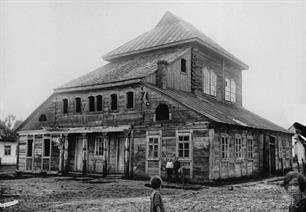 |
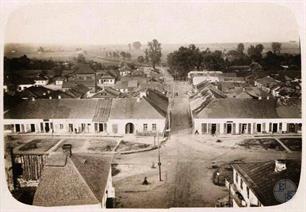 |
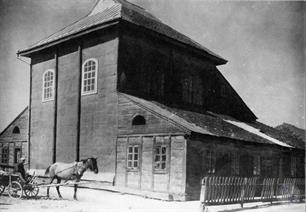 |
| Synagogue in Poryck, before1929 | Poryck, 1916. Thr synagogue is visble on the left | Synagogue in Poryck, 1934. Photo by Jan Bulhak |
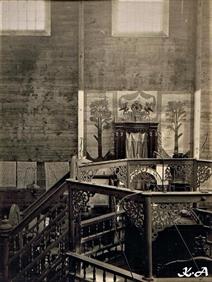 |
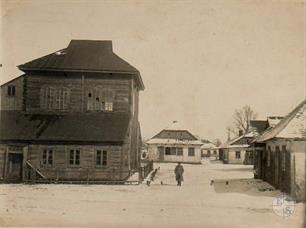 |
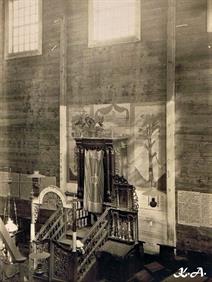 |
| Bimah, beginning of the XX century | Synagogue in Poryck, beginning of the XX century | Aron Kodesh, beginning of the XX century |
After September 17, 1939, with the entry of the Red Army into the town following the Ribbentrop-Molotov Pact, Poryck became part of Soviet Ukraine. It is estimated that in 1941, after the beginning of the Soviet-German war, the Jewish population reached 3,000 as refugees from Nazi-occupied Poland streamed into the town.
The Germans captured Poryck on June 23, 1941. In late August or early September, 1941 the Germans shot to death about 100 Jewish men, women, and children in the forest outside the town. In the summer and fall of 1941 the Germans implemented a series of anti-Jewish measures in Poryck.
A night curfew was imposed on the Jews and they were ordered to wear armbands bearing the Star of David (later replaced with a yellow circle on their chests). They were also subjected to heavy forced labor, prohibited from leaving the town, and victimized by systematic beatings by the Ukrainian police.
The Germans also established a Jewish council (Judenrat) to transmit their orders to the Jewish population.
From the summer of 1941 and in 1942 the German authorities imposed a series of "contributions" on the Jewish population, compelling them to hand over all valuables and fur clothing.
In the winter of 1941-1942 or the spring of 1942, the Germans established an open ghetto in Poryck, as they resettled the Jews from the surrounding villages in the town. This resulted in considerable overcrowding and the spread of disease, including typhus. A hospital existed inside the Jewish quarter of Poryck.
On September 1, 1942 members of the German Gendarmerie (rural order police), assisted by Ukrainian auxiliary police, burst into the ghetto and shot to death Jewish patients in the hospital and some elderly Jews who were unable to walk. The rest (mainly women and children) were taken to the village of Przesławicze, where they were kept in the camp there.
After three days, during which time approximately 300 people died, the remaining Jews were taken from the camp to the Kuczkуw farmstead, where they were shot to death. This murder operation was concluded on September 5, 1942. It is estimated that about 2,000 Jews from Poryck and its surroundings were murdered at this time. According to one testimony, about 100 Jews who had fled from Poryck at the start of the murder operation were soon recaptured and taken back to town. There the Ukrainian police cut off their hands or other parts of their bodies and then burned them alive in the remaining Jewish houses.
Poryck was liberated by the Red Army on July 18, 1944. In 1945 the town was renamed Pavlivka.
The Germans captured Poryck on June 23, 1941. In late August or early September, 1941 the Germans shot to death about 100 Jewish men, women, and children in the forest outside the town. In the summer and fall of 1941 the Germans implemented a series of anti-Jewish measures in Poryck.
A night curfew was imposed on the Jews and they were ordered to wear armbands bearing the Star of David (later replaced with a yellow circle on their chests). They were also subjected to heavy forced labor, prohibited from leaving the town, and victimized by systematic beatings by the Ukrainian police.
The Germans also established a Jewish council (Judenrat) to transmit their orders to the Jewish population.
From the summer of 1941 and in 1942 the German authorities imposed a series of "contributions" on the Jewish population, compelling them to hand over all valuables and fur clothing.
In the winter of 1941-1942 or the spring of 1942, the Germans established an open ghetto in Poryck, as they resettled the Jews from the surrounding villages in the town. This resulted in considerable overcrowding and the spread of disease, including typhus. A hospital existed inside the Jewish quarter of Poryck.
On September 1, 1942 members of the German Gendarmerie (rural order police), assisted by Ukrainian auxiliary police, burst into the ghetto and shot to death Jewish patients in the hospital and some elderly Jews who were unable to walk. The rest (mainly women and children) were taken to the village of Przesławicze, where they were kept in the camp there.
After three days, during which time approximately 300 people died, the remaining Jews were taken from the camp to the Kuczkуw farmstead, where they were shot to death. This murder operation was concluded on September 5, 1942. It is estimated that about 2,000 Jews from Poryck and its surroundings were murdered at this time. According to one testimony, about 100 Jews who had fled from Poryck at the start of the murder operation were soon recaptured and taken back to town. There the Ukrainian police cut off their hands or other parts of their bodies and then burned them alive in the remaining Jewish houses.
Poryck was liberated by the Red Army on July 18, 1944. In 1945 the town was renamed Pavlivka.

- Home
- Shtetls
- Vinnytsia region
- Volyn region
- Dnipro region
- Donetsk region
- Zhytomyr region
- Zakarpattia region
- Zaporizhzhia region
- Ivano-Frankivsk region
- Kyiv region
- Kropyvnytskyi region
- Luhansk region
- Lviv region
- Mykolayiv region
- Odessa region
- Poltava region
- Rivne region
- Sumy region
- Ternopil region
- Kharkiv region
- Kherson region
- Khmelnytskyi region
- Chernihiv region
- Chernivtsi region
- Cherkasy region
- Crimea
- Synagogues
- Cemeteries
- Objects & guides
- Old photos
- History
- Contact
Jewish towns of Ukraine
Jewish towns of Ukraine
My shtetl
My shtetl
Donate
